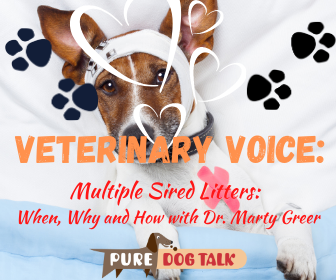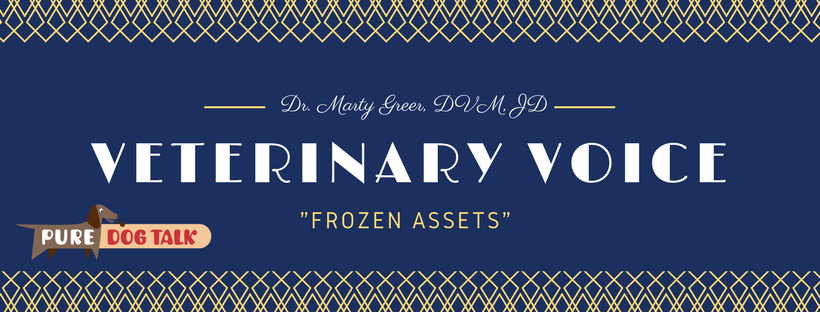606 – Protecting Breeds Into the Future
Protecting Breeds Into the Future
Dr. Marty Greer, DVM joins host Laura Reeves to discuss AKC’s newest service for preservation breeders. Greer was actively involved in AKC’s development of the Purebred Preservation Bank, taking the idea from the Otterhound Club of America. We had the conversation with Joellen Gregory early on about the Otterhound’s semen bank, and AKC has taken this and developed it into something that’s available for all parent clubs.
“(PPB will allow) AKC to fund the long -term storage of semen that no longer has an owner that wants to manage it,” Greer said. “So, you don’t necessarily have to have passed away for this to happen. If you’re at the end of your breeding program and you’re sitting there with six beautiful dogs that have semen frozen, and you’re like, ‘Well, I don’t have anybody I’ve really mentored and my kids don’t want it, so where do I go with this?’
“That’s when you go to the AKC website, you pull up the information on there, you sign the document that allows AKC to take ownership. And once you hand it off, you no longer are in control of that part of the semen. You may send all of your dog’s semen, you may send part of that dog’s semen, you may send all the semen that you have to the AKC, and AKC will then pay for the long -term storage.
“Every breed club makes their own rules. Your parent club can put together their health committee, their genetics committee, a special committee for this. Your breed club will sit down and with some ideas from what other breed clubs have done, be able to say, ‘This is how we want the semen disseminated. Does the bitch have to have a CHIC number? Does she have to have these certain criteria? When is it appropriate to use? Has she had a litter before?’ All those kinds of things, your breed club can decide.
“But as you release the semen, you can’t say, ‘Well, I don’t like Susie Smith.” Susie Smith is never going to get to touch my semen ever, ever, as long as I live, over my dead body. Maybe it will be over your dead body because now it’s no longer yours.
“Fifty years from now and 100 years from now, that’s what we’re looking at. We’re not looking at what happens next Tuesday when a bitch has to be bred. We’re looking at 100 years from now. Is your dog still of value? You might say things like, ‘Well, styles of dogs change,’ and indeed they do. But sometimes those foundational dogs are structurally what you need. Sometimes those foundation dogs predate certain genetic disorders that have really worked their way deeply into the gene pool and could be very hard to breed your way out of.
“AKC’s role in this is to pay for the semen storage and to register the puppies. That’s it. AKC is not there to start saying, ‘Well, we want you to do this with this and we want you to do that with that. And you have to have faith that 100 years from now, this mission, this vision is going to be held true. But it’s not about Susie Smith. It’s not about you. It’s not about (any individual dog). It’s about the overall health of the breed and where we can go with some of the genetics.”
475 – Multiple Sired Litters: When, Why and How with Dr. Marty Greer
Multiple Sired Litters: When, Why and How with Dr. Marty Greer
Dr. Marty Greer and host Laura Reeves review the when, why and how of multiple-sired litters. AKC instituted the policy for multiple-sired litters in 2000 with the advent of reliable parentage DNA testing.
Planning for a multiple-sired litter requires taking a variety of factors into consideration.
- The quality and condition of the semen. Greer notes that poor-quality semen should get a “head start” and be inseminated first. Frozen, fresh chilled and live semen all have different rates of motility and viability as they journey toward the eggs.
- The age and reproductive viability of the bitch. Greer advocates for a first litter. “I like a pink, shiny, healthy new uterus,” Greer said. “But it’s got the risk of not knowing what her fertility is and it’s got the risk of not knowing what kind of maternal skills she has.”
- Cost is a factor, as sire, dam and all puppies require DNA parentage testing through AKC in order to be properly registered.
- The “relatedness” of the sires being considered. While DNA testing can differentiate related sires, a father and son or similar closely related dogs can be more challenging to nail down. “We had a Border Terrier… usually they go out, I think, 13 genes and they had to go out 23 because the dogs were so closely related,” Greer said.
- The knowledge and experience of your veterinarian. “(Work) with somebody that does a lot of canine reproduction. This is not for your ordinary, garden variety veterinarian. Those are good people, don’t get me wrong, but when you’re doing something of this level of sophistication, you need to have somebody that doesn’t misunderstand what you want to do and doesn’t think that fresh chilled semen goes in the freezer and knows how to put it in so that it gets into the uterus.”
- Freeze potential sires while they are young and healthy. “If you have a young up and coming stud dog, freeze early and freeze often. Even if it’s not up and coming, even if it just might be up and coming … if he’s good enough for you to keep, freeze him. You can always do the health screenings later.”
- Consider creating a “sperm bank” for your national breed club. Working with AKC, Greer said the prototype created by the Otterhound Club of America is now available to all clubs. “We’ve got a tool kit put together. Our next step is to start educating breed clubs. So if you’re listening and you have a breed club and you’re on the genetics committee or you’re a member or you have a dog that you would like to have semen retained on this is really really, really super important. We’re going to need to breed our way out of some of these corners and without that genetic material stored, it’s not going to happen. So, you now have the opportunity to work with your breed club, your veterinarian, the AKC, the society for theriogenology… there’s a whole bunch of people that are involved in this because everybody sees the big picture value of this.”
440 – Successfully Collecting, Shipping and Freezing “Swimmers”
Successfully Collecting, Shipping and Storing “Swimmers”
Shannon and Sydney Stone from ICSB NorCal join host Laura Reeves for a detailed and educational conversation about collecting, shipping and freezing a stud dog’s semen, aka “swimmers.”
Mother and daughter share their vast experience with different extender media, freezing methods and tips and tricks for a successful collection of the stud dog.
Test drive extenders
For fresh chilled collections, Shannon strongly advocates for collecting a potential stud dog and doing a “chill test.” This enables the practitioners to save the semen in a variety of available media in order to be sure which one works best with the specific dog. Dogs are individuals and not all semen will survive in every media. It is critical to know this *before* that super important, exciting breeding that has been planned for years.
“It just basically boils down to finding the best media for your dog,” Shannon said. “There’s so many good medias on the market right now, it’s just what’s the best fit for your dog and what works best for you as a stud owner.
“Some of the best collections we see are ones where either the owner has a centrifuge or they took the dog to the vet and the collection is centrifuged and we’re only getting that sperm rich fraction added to the media.
“Kind of a rule of thumb that we’ve seen is, no matter what media you’re using, you can expect that … the loss of integrity to be about 20% per day that you’re holding a sample. So say you get a sample in on Friday or Saturday but the bitch really isn’t gonna be ready to breed til like Monday or Tuesday. We can check the semen and if we need to add a little bit, as long as we know what media was sent in, you can sometimes add a little fresh media to perk it up.
“What we say to our clients that are going to be shipping basically … a sample is always better in the bitch than in the box.”
Pellets vs straws
Frozen semen is stored in one of two methods. As “straws,” the original method developed by cattle breeders, often called “cattle straws” and “pellets” the method developed originally by ICSB. Sydney recommends, again, a freeze test to be sure which method is best for the individual stud dog.
The primary importance, Shannon noted, is to work with a veterinarian who is accustomed to the type of freezing method chosen. Thawing pellets and straws is two completely different processes. Using the wrong thaw method for the type of frozen semen will kill it immediately.
Collection Tips and Tricks
Technique, a teaser bitch and a relaxed stud dog are the keys to success, the team agreed.
“You have to know your dog and kind of change things up to accommodate him,” Shannon said. “It’s not one size fits all.”
Listen to our previous stud dog series with Shannon and Sydney here, here, here and here.
180 – Veterinary Voice: Dr. Marty Greer Talks “Frozen Assets”
Dr. Marty Greer Talks “Frozen Assets”
Frozen semen is an investment not only in one family of dogs, but in the future of the breed in question. Dr. Marty Greer, DVM, JD takes us through a checklist of important considerations for preserving genetic material from our best dogs.
First, Greer said, be sure the semen is stored in a safe facility. Sometimes even storing the same dog’s semen in more than one facility is worth the cost.
Greer’s story about a private semen storage whose owner passed away without a will in place is a cautionary tale.
Insure the Future with Frozen Semen
Second, make provisions for transfer of semen ownership, whether in a will or trust, Greer said. This vital step will ensure the safety of valuable genetics.
“Don’t look at it as your dog line’s future,” Greer said, “but take a step back and look at it as the future of your breed.”
She contends the value of frozen semen is that the best dogs are what we have in frozen. Improvement in testing for diseases means we can use genetic material even if it is imperfect, by using DNA testing to line up the frozen semen with an appropriate bitch.
“If we can test their semen … they’ve got preserved,” Greer said “and use those to match with the appropriate bitches, we can really move our breeds forward, if we’re willing to think hard about this and not just be looking at that little tiny bit of your genetic material but look at your breed as a whole …”
Greer is a strong advocate for planning ahead for the transferal of frozen semen ownership. And to consider sharing it outside one’s own breeding program.
“And in our semen freezing contracts we have a provision made for how that semen should be transferred,” Greer said. “You should have it in your will. You should talk to your attorney about it and a lot of attorneys are going to be unfamiliar with this kind of transaction. So you’re probably going to want to talk to somebody that has some expertise. Somebody in a legal position that they’ve either got a dog ownership and they’re attorneys as well. Debra Hamilton does a lot of work with trust for dogs.”
Another point Greer makes is acquiring insurance for the storage of the semen.
“ I have a few clients that have purchased old semen from their mentors,” Greer said “and they may have 10 to 20 dogs frozen and so they may have a good deal of financial investment in that. … insurance is available through a small number of companies but don’t count on it being insured at the place that you’re storing it.”
Greer also provides input on how to estimate fair charges for owners who will sell vials of frozen semen to other breeders.
Listen today for all of Greer’s great advice.
And if you missed it, you can listen to our interview last summer with Debra Hamilton on the topic of creating plans for the future of your dogs, breeding program and more at this link: https://puredogtalk.com/96-divorce-disease-disaster-disability-delay-death-and-your-dogs-debra-hamilton-esq-how-to-make-a-maap-plan-2/




